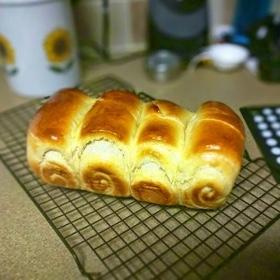
Ingredients
- Roux
- 6 tbsp water
- 2 tbsp flour
- Bread Dough
- 1 1/4 tsp active dry yeast
- 1/4 cup milk (lukewarm temp)
- 350 grams all-purpose flour
- 1/4 cup granulated sugar
- 1 pinch salt
- 1 each large egg
- 1 tbsp dry milk powder or condensed milk
- 1/4 cup heavy whipping cream
- 2 tbsp unsalted butter
- Egg Wash
- 1 each egg
- 1 a splash of milk
Directions
In a small sauce pan, combine your flour and water. Heat over medium to low heat. Stir or whisk until you get the consistency of gel. Do not walk away, or you will “roux” the day. Set aside to cool after you are done.
Wake up the yeast by combining it with the lukewarm milk. Make sure it is not too hot or you will kill your yeast. Test your milk against the back of your hand, it’s the “yeast” you can do.
In your mixer bowl, combine the following dry ingredients.
In a smaller bowl, combine your yeast mixture, roux, egg, powdered milk, and cream. Whisk together.
Set your bowl with the dry ingredients on your mixer with the dough hook attachment.
In the bowl, make a well and pour your egg-cream mixture in the middle. Set the mixer to the lowest setting to combine until the dough starts taking shape.
At this point, ask yourself, “where does the butter go?!” and you re-read your instructions. You didn’t forget it.
Add one tablespoon of butter, until it is incorporated, then add the other tablespoon until incorporated.
Set your mixer to knead until the dough is stretchy. I had to take the dough out several times and knead by hand on a floured surface to check the consistency. You don’t have to, but it’s good to know the texture of what I’m looking for. If you’re a beginner like me, there is a “knead” to do this.
Preheat your oven to the lowest setting (150 to 170 degrees) and turn off while the mixer is kneading your dough.
When you knead by hand, you should have a slightly sticky (post-it tacky), a little bit oily dough.
Knead by hand until you can make a neat ball. You’ve reached a good point in the dough of you poke the dough and it slowly bounces back. It was at this point that I realized “Holy crap, so that’s why the Pillsbury doughboy gets poked! It’s a shout out to this part of the process!” Now imagine your dough laughing every time you do this.
Put your dough back into the bowl. Wet your hand and sprinkle with a little bit of water. Cover with plastic wrap and put in the warm oven.
To be honest, I forgot about the dough in the oven until after 3 hours later. Don’t worry, it’s a good thing. Throw out your time tables when it comes to making bread and look for the right smells, the right consistency instead. You want the dough to rise until it becomes double in volume. If its still small, give it more time. If you haven’t killed all of the yeast, all it takes is time for the dough to rise.
Take the dough out on your floured surface and punch it. Get everyone in the house to take a whack at it. You want it as bubble free as possible.
Prepare a loaf pan and line with parchment paper. Preheat oven to the lowest setting, then turn off.
Form your dough into a log and portion into 4. Put the other 3 balls in the mixer bowl and cover with your wrap while you work on one.
Roll your ball into a flat shape, then fold in thirds. Flatten the dough, and then roll it up into a log. Put the log in your pan and do the same for the other balls.
Cover pan with plastic wrap, then proof the final shape in the oven.
Your dough should look like this at the end of proofing. Again, because I was watching a movie at the time, I forgot that this was proofing. Forgetting helps, because look what came out!
Preheat your oven to 350°F.
Brush the loaf with your egg wash (beat together egg and milk; ingredients below) and bake for about 25 to 30 minutes. It looks like a nice caramel top and feels hollow when you tap the crust.
Take your bread out of the pan as soon as it comes out, and then take off the parchment paper as soon as the bread is cool enough to handle. The bread is mmmmmmmoist inside and the condensation will build around the bread and will make it soggy. Done!